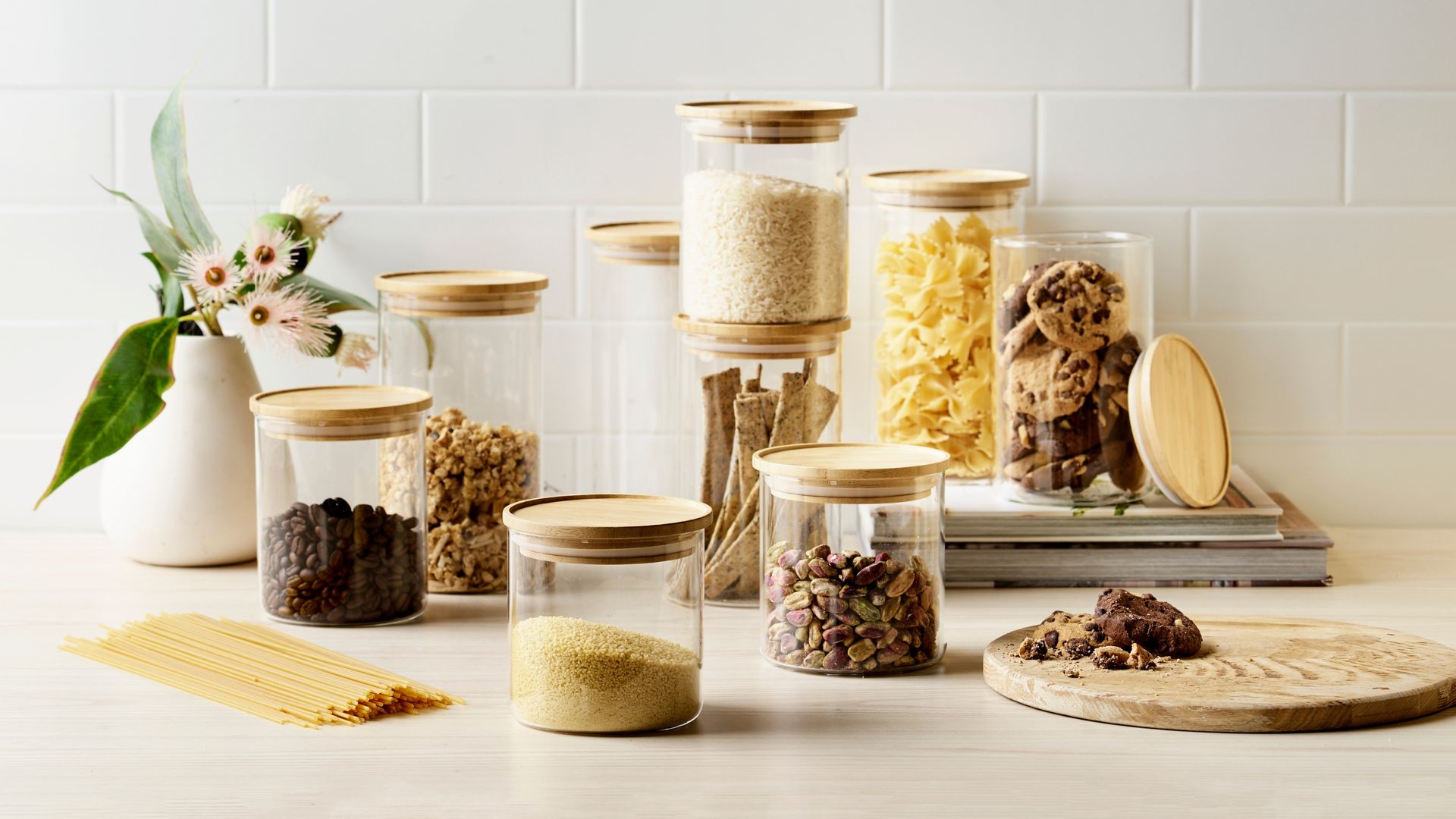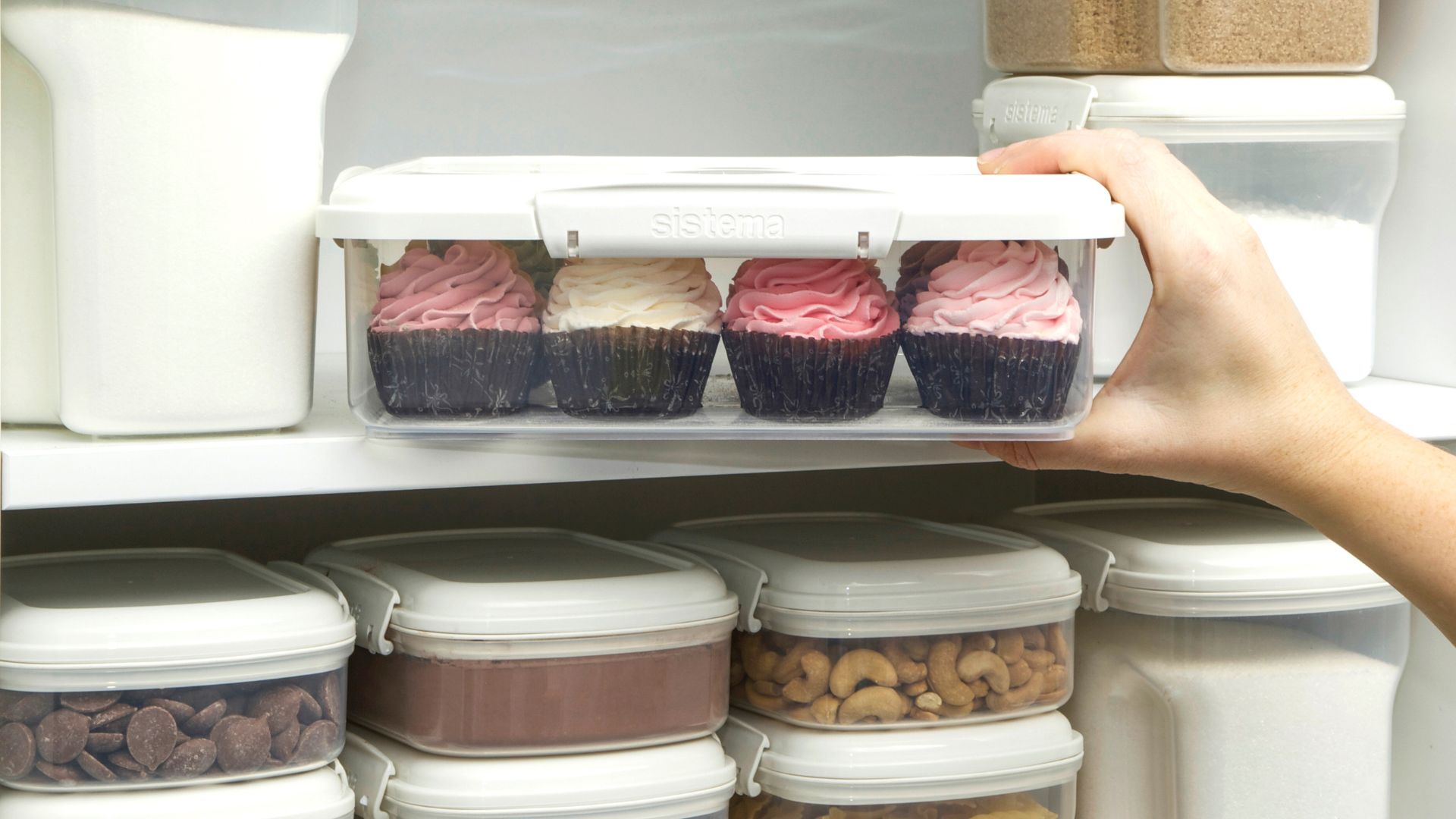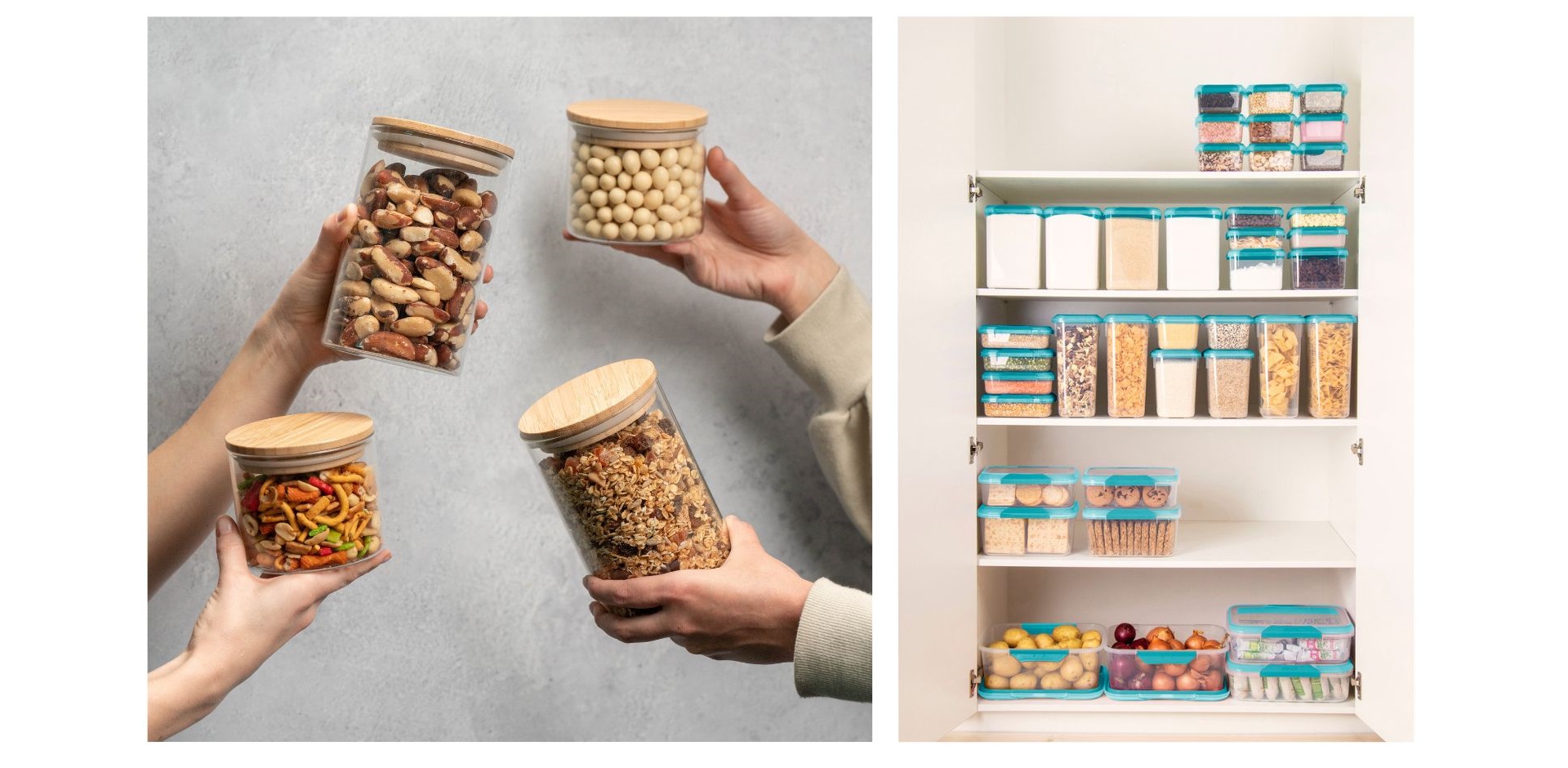 | ||
| Your browser is not supported. | ||
|
Please browse our site using any of the following options:
| ||
Pantry organisation ideas & how to organise your pantry

Pantries serve an essential role in our homes, keeping our food clean, dry and away from animals and pests. But after doing your grocery shopping, making the effort to put away everything neatly can just be a little too much. So we chuck our groceries in the pantry, shut the doors and think no more of it.
But have you ever searched for way too long in your pantry for that one jar of spices you're sure you have? Gone to pull out a box of cereal and had two more things slide out with it? Or gone to put away a bag of rice only to see there's a half-used one stuffed at the back of your pantry? Sounds like you might need some new pantry organisation ideas!
At Spotlight we love a tidy kitchen, and we are delighted to offer a huge range of pantry storage jars, containers, trays and more. Need a little more help with your pantry organisation? Read on and let us show you how to organise your pantry!
Quick links
- Why should I organise my pantry?
- How to organise your pantry?
- Pantry pests and how to keep them out.
- How can I store things outside my pantry?
Why should I organise my pantry?
Maybe you love your pantry the way it is, and that's okay! But good pantry cupboard organisation can lead to benefits you may not know you need.
It makes cooking quicker and easier
Making delicious food can be simple, but it often involves a lot of ingredients in specific quantities. Knowing where all your foodstuffs are can make fast cooking easy, especially if you need to add ingredients quickly. You don't want to be digging through your kitchen pantry storage while your dish overcooks on the stove behind you! Having an organised pantry means you can find what you need when you need it.
It stops you from buying repeat items
There's nothing worse than buying a new pack of food, only to find you have a half-used one hiding in the back of your pantry. Not only do you now have to find extra space for the new product, but you have twice the amount of food to use before it expires. Save money, space and stress by having everything in your kitchen pantry storage clear and visible at all times.
It keeps food fresher for longer
One of the main pantry organisation points we'll explore later is transferring dry goods into clear, sealed containers. While it is tempting to use a bit of something and then either close the box or roll it up, this will not provide an air-tight solution and it can cause the contents to go stale. Storing things in air-tight containers provides a totally sealed environment that will keep your food fresh for much longer, leading to less food wastage and saving you money in the long run.
It looks great!
Let's face it, there's something nice about an organised area. Whether it's your linen closet, wardrobe or pantry, having your belongings neatly organised and tidy will provide that little burst of dopamine we crave every time you see your hard work. So have fun organising your pantry and feel proud showing it off to family and friends!
How to organise your pantry
Now that you're ready for some pantry cupboard organisation, let's get started. The following tips are suitable for pantries of all sizes, but we'll be sure to mention any size-specific tricks you should know if they come up.
Clean out your pantry and cull old items
Take everything out of your pantry and lay it out on a bench or table. Once your pantry is empty, clean the walls and shelves with a mixture of warm water and vinegar - stay away from chemicals like bleach and ammonia, as you don't want them near your food. While the shelves dry, go through your food and throw out anything that has expired - you may like to make a shopping list to replace anything you need.
Add lighting for hard-to-reach spots
If you have a pantry with dark spots, adding some warm lighting will make finding things a lot easier. Keep in mind your options will depend on if you have an outlet available or if you will be limited to battery-powered lighting. There are lots of good options out there for pantry lighting, including:
- Motion sensor lighting - this is a great lighting option that, once installed, requires no effort to operate. A motion sensor light will come on when you enter the pantry, so they are well suited to walk-in varieties. If you don't have an outlet, these are a good option because they can't be left on accidentally!
- Light strips - strips of lighting along a shelf can help illuminate your food from below, rather than creating harsh shadows from above.
- Automatic door switch - a more technical option is a light wired to turn on when the pantry door opens and turn off when it closes. The sensor is placed in the doorjamb, so if the pantry door isn't shut properly then this light will stay on.
- LED downlights - the last simple option is LED downlights operated with a switch. These lights provide bright illumination from overhead and are cheap to run.

Sort into clear containers, baskets and bins with labels
Here comes the important part. You'll want to get yourself some clear containers that can be firmly sealed to be air-tight. Glass or plastic are both fine - what's important is that you can see inside. We have a fantastic range of clear storage containers, but you can just as easily use old jam and sauce jars for the same purpose. If you are buying containers, try to grab ones that can stack easily.
Metal canisters are strong but obviously, you can't see inside - if you really want to use them, there are plenty of inscribed metal containers you can use for storage. They are great for storing things like biscuits, coffee and other dry foods that don't go stale easily.
Pop whatever you can into these containers. Pasta, flour, sugar, rice, beans, cereal, oats, spices and nuts are all great contenders to be stored out of their commercial packaging, as they are usually opened but not used all at once.
For foods that come in serves, like small chip packets, soup sachets and gravy mixes, you can store them in easy-to-pull-out baskets or trays.
Use a label maker or washi tape and a strong marker to indicate what is in each container, as well as the expiry date if applicable.
Sort containers by type and usage
Once your pantry shelves are clean and dry you can start putting your food back in. To start with, group your pantry goods together by type. Sauces, baking goods, tins, spreads, pasta, oils and rice can all be grouped together on shelves. It's also helpful to pop things with closer used-by dates at the front to encourage their use before they expire. Things that are used a lot can go on eye-level shelves, while dry goods you only use occasionally can go higher up. If you have hungry kids, keep healthy snacks near the bottom where they can reach (and sneaky treats hidden up high!).
Hang racks on the back of doors
If your pantry has doors that open outwards, you can add a little extra storage space by attaching sturdy racks to the backs of each door. Because they will be moved every time you open the pantry, avoid storing fragile containers in these racks. Raw goods like onions and potatoes and packaged goods like lentils, dog food and instant noodles are all contenders for pantry door storage.
You can also use these racks for storing cleaning tools like paper towels, serviettes and clean sponges.
Pantry pests and how to keep them out
No matter how clean your kitchen and pantry are, sometimes you'll be unlucky enough for pantry moths and weevils to make their way inside. Kitchen pantry storage pests usually make their way in by smuggling themselves in goods and bags from the supermarket, and they can be very hard to detect unless you carefully inspect your groceries before you buy them.
Pantry moths
The Indian Meal Moth has been a blight on many a kitchen, and by the time you see them, it's often too late for an easy solution. An adult moth is only around 1.2cm long and they love to hang around foods like grains, cereal, flour, pasta and dried nuts and fruit. Females will lay their eggs in these foods and the larvae will eat and contaminate any food they are in, so it's important if you see any signs of pantry moths to get to work quickly to save your food!
To get on top of a pantry moth infestation:
- Take everything out of your pantry and give all your dry goods a thorough check. The eggs are too small to see, so instead look for webbing from cocoons and the moving larvae.
- Bag any infested food into a sealed plastic pocket and bin it. Make sure to quickly dispose of the bin bags outside, preferably into your large garbage bin that gets collected. The rest of the safe food can go back into sealed containers. If they weren't in air-right containers before, now is the time to transfer them.
- Use a vacuum to clean out your pantry, making sure that any cocoons and webbing are sucked up. Empty the vacuum and seal the bag before moving it into an outdoor bin as well. Clean your pantry with a mixture of vinegar and warm water after.
- If you notice a lot of moths flying around, a sticky trap will help eliminate them. Keep in mind these only attract male moths, so you will still need to keep an eye out for the females hanging around your food. But if you have properly sealed and stored your food away, they will have nowhere to lay their eggs and will die off - adult pantry moths cannot eat, and only exist to mate and lay eggs.
Pantry weevils and beetles
The crawlers you usually find in your pantry are called flour beetles and rice weevils. Luckily, the ways to deal with them are very similar to that of pantry moths, although they are sometimes less obvious to see because they don't always fly.
As their name suggests, you'll usually find weevils in flour and beetles in rice bags - checking the bags at the supermarket for holes, web or chew marks can be a good reason to leave that bag on the shelf.
The cleaning process for getting rid of pantry weevils and beetles is the same as with moths - if you want to kill them before binning the food, you can freeze the contaminated food for a few days or roast it in the oven for a few hours to kill any insects and larvae.
Preventing pests
There are a few steps you can take to stop pantry pests from making their way into your home:
- While they can occasionally enter through gaps in your home from the outside, pantry pests usually come already inside food from the grocery store. When buying foods like flour, rice and cake mix, inspect the packaging for holes, bite marks or even webbing.
- Pantry pests can chew their way through thin plastic or cardboard packaging, so if you are keeping food in these materials be sure to inspect them often for signs of life. Otherwise, keeping your food in strong, thick plastic or glass containers will keep them at bay.
- While it isn't a scientifically-proven prevention, many people swear by bay leaves as a natural repellent for pests due to their smell. Hang fresh or dried bay leaves in your pantry and let them work their magic.
If you are unlucky enough to have pantry pests in your home, don't panic. None of them can hurt you or your pets and they can't damage your home in any way, besides spoiling your food. And if you look down at your bowl of cereal and see a half-eaten critter, don't worry - they're also safe to eat!

How can I store things outside my pantry?
If you've cleaned, organised and tidied your pantry and you're still running out of room, there are a few more sneaky ways you can store food and kitchenware out in the open.
Hang pots and pans from racks
Pots and pans are essential for cooking many of our favourite meals, but due to their large size and shape they can be tricky to store. Plus if you have lots of them, getting them out of a drawer or cupboard can be a hard and noisy affair.
Luckily most cookware will have a small hole in the handle that makes hanging them up a viable option! You can create a peg rail and hang them from a wall or even attach hooks to a hanging rack and hang them above an island or benchtop. It creates a surprisingly homey and rustic feel, plus it makes access to your pans easy. Just make sure to hang them high enough there's no chance of banging your head on them - the noise will be funny, but the ache afterwards won't be.
Display spices in a rack
If you love adding dried herbs and spices to your cooking then a spice rack will save you a lot of time and effort rummaging through the dozens of small glass bottles in your pantry or kitchen drawer. A spice rack can be a free-standing structure on a bench or a rack that has been hooked onto or attached to a flat wall. There are even multi-level racks for spice lovers and they come in wood, metal and plastic varieties to suit your kitchen.
Keep metal utensils on a magnetic strip
Bulky metal kitchen tools like knives, ladles, spatulas and tongs can take up lots of space in your pantry or kitchen drawer, but if they're made of metal you can invest in a magnetic strip to adhere them on! This strip can be adhered to a wall in your kitchen and is a hygienic and attractive way to store your larger metal utensils. Make sure to keep this strip out of reach of children and pets, as the magnet will be strong enough to keep the tool stable but not so strong they can't be removed with a little force.
Tidy your pantry with Spotlight
We hope we've inspired you to give your pantry a good tidy! You can find everything you need for pantry storage and pantry organisation on Spotlight's online store, where your purchase can be delivered to your home or picked up as a click and collect. Otherwise, feel free to head to your nearest Spotlight store to view our extensive pantry storage range in person.
For everything else you could need for your kitchen, check out our kitchen and dining online hub! And if you're still unsure about what to buy, have a read of our kitchen buying guides, including the one on kitchen storage.




